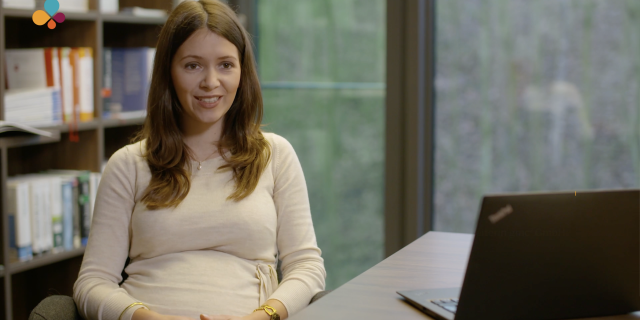The new normal: hybrid working
It doesn't work without trust Work organization in hybrid teams
The world of work is constantly evolving. Digital tools and new processes offer the opportunity to make work even more efficient and flexible. This is also directly driving forward the work-life balance. But not every employee wants to do without personal interaction in the office. How can these aspects be reconciled in the future? Consultant Kirsten Wallmichrath knows the answer.

New demands on leadership, changing power structures, a departure from old structures - consultant Kirsten Wallmichrath calls for better communication and more trust. The senior consultant and head of diagnostics at the Cologne-based management consultancy meta five Gmbh focuses on personnel and organizational consulting. She is the author of the study "Leadership in the new normal", in which she surveyed around 100 HR managers and executives from various sectors. We spoke to her about the results:
Mrs Wallmichrath, what changes are managers facing with regard to hybrid working?
A large number of surveys indicate that work organization will not return to the old way of doing things - and that's a good thing. Mobile working is a great relief, especially when it comes to balancing work and family life. In many companies, hybrid teams consisting of employees in the office and working from home will form. Personnel management can no longer be carried out "en passant" and on the side, as it was in the days of being present, but requires significantly more planning. Managers need new, individual concepts that are tailored to the requirements of the company and the teams in hybrid operations. The situation is basically not new. There have always been individual employees, mostly women with young children, who have worked from home. Now the issue is affecting significantly more employees, so managers are well advised to develop a flexible and future-oriented management strategy.
Where are the pitfalls and what should managers pay particular attention to?
The communication and management work required here should not be underestimated. Coordinating hybrid teams while maintaining a harmonious working atmosphere in which all employees feel seen and considered can be challenging at times. It is therefore important that there are enough exchange rounds, meetings or check-ins to get everyone on board. This can also include topics outside of the job. Creative communication formats such as morning coffees or the organization of private get-togethers can complement the chance encounters and friendly exchanges at the coffee bar and also integrate those who are not on site at the company. Many managers see themselves as learners in this change process and are currently looking for the right forms and formats of communication for their company.
At the same time, some managers have to say goodbye to traditional notions of leadership culture. The belief that control and presence are necessary conditions for productive work has now been widely refuted. Nonetheless, there are still some managers who, for example, want to hold on to it out of habit or for other reasons. However, it is also in their own interest to seize the opportunity that now presents itself and move away from this outdated management style. After all, qualified specialists will think twice about working for a company that is rather restrictive when it comes to working from home and mobile working. Managers should encourage employees to take control and delegate responsibility in order to enable successful work and create trust.
As a manager, how do I build a good relationship of trust with my employees when face-to-face meetings are becoming rarer?
Hybrid forms of work can change the working dynamic within the team. Building or strengthening mutual trust is therefore an essential task. Managers should be able to recognize needs and requirements. Precise agreements that are clearly communicated and continuously adapted are helpful. Tools for digital project management can also provide support here, but are not enough on their own. Overall, it is worth paying more attention to the digital management culture at all levels. After all, this can increase employee satisfaction - not least through better opportunities to balance work and family life - and make the company more attractive to future employees through good employer branding.
Checklist: Your path to the new normal
Trying out new working models can be worthwhile. In the future, it will be important to agree on requirements, find new hybrid forms of collaboration and expand these to enable greater flexibility. In order for this to work profitably for everyone, other aspects are important in addition to the technical equipment:
-
Guidance
Don't design new models on the drawing board. Talk to your employees and ask them what works well in their home office and what doesn't. This can provide insights into, for example, when it makes sense to continue meeting in the office in the future, which tasks can be completed just as efficiently from home and which problems still need to be resolved so that working from anywhere is equally possible and compatible with family and private life. Only together can you develop solutions that work for everyone. Surveys using online voting tools, for example, can provide an initial picture of the mood, which you can use as a basis for driving forward suitable measures.
-
Internal communication
Internal communication in other areas must not suffer as a result of hybrid forms of work either. Make sure that you keep your employees informed about developments in the company in a transparent manner. Also engage in a dialog, as this is the only way to get everyone involved and on board. For example, set up the classic, well-known suggestion box, which your team can use to submit suggestions - anonymously if they wish. This can also be done digitally, for example via the so-called Miro Board, an online-based whiteboard tool on which you can record the latest information and give your employees space for comments.
-
Team cohesion
If employees increasingly work from home in the future, chance encounters in the kitchenette will become a thing of the past. New communication channels such as chat rooms, for example, will help people to spontaneously exchange ideas and stay in touch, even in virtual space. But also think about which events should take place face-to-face again. Company celebrations, for example, develop a different dynamic in real life than via a video conference.
-
Further training
Employees may need new skills for the new work processes: How will the new software be operated? How can collaboration be organized via the new communication channels? How will contact with customers change? They need support and training for questions like these. More and more providers are taking up the topic in their seminars and, for example, addressing the question of how balanced hybrid teams can be set up. There are already approaches for implementation in which participants are partially on site and digitally connected.
Good company examples from practice
Where can we find help and advice?
In the toolbox on the "ZEITREICH" project website, you will find lots of helpful ideas for agile, flexible and mobile working:
https://projekt-zeitreich.de/toolbox/
The "Erfolgsfaktor Familie" corporate network offers you the opportunity to exchange ideas with other companies and experts. Membership is free of charge and offers lots of practical information and support for implementation in your company.
https://www.erfolgsfaktor-familie.de/erfolgsfaktor-familie/mitmachen-im-netzwerk




